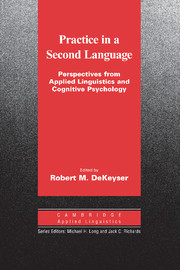Book contents
- Frontmatter
- Contents
- List of contributors
- Series editors' preface
- Introduction: Situating the concept of practice
- I: FOUNDATIONS
- II: INSTITUTIONAL CONTEXTS
- Chapter 5 A cognitive approach to improving immersion students' oral language abilities: The Awareness-Practice-Feedback sequence
- Chapter 6 Second language education: Practice in perfect learning conditions?
- Chapter 7 Meaningful L2 practice in foreign language classrooms: A cognitive-interactionist SLA perspective
- Chapter 8 Study abroad as foreign language practice
- III: INDIVIDUAL DIFFERENCES
- Conclusion: The future of practice
- Glossary
- Index
- References
Chapter 5 - A cognitive approach to improving immersion students' oral language abilities: The Awareness-Practice-Feedback sequence
Published online by Cambridge University Press: 27 January 2010
- Frontmatter
- Contents
- List of contributors
- Series editors' preface
- Introduction: Situating the concept of practice
- I: FOUNDATIONS
- II: INSTITUTIONAL CONTEXTS
- Chapter 5 A cognitive approach to improving immersion students' oral language abilities: The Awareness-Practice-Feedback sequence
- Chapter 6 Second language education: Practice in perfect learning conditions?
- Chapter 7 Meaningful L2 practice in foreign language classrooms: A cognitive-interactionist SLA perspective
- Chapter 8 Study abroad as foreign language practice
- III: INDIVIDUAL DIFFERENCES
- Conclusion: The future of practice
- Glossary
- Index
- References
Summary
Consider the experiences of a grade-12 student who has studied French for a total of 13 years in Alberta, the first few years of which were in a total immersion program where all instruction was in French. She travels to Montreal for the first time. To her great shock, she finds that she is unable to use her French very much because the bilingual speakers she comes into contact with switch to English the minute they hear her speak. She comments, “I quickly realized … that my French is not the same as Quebecois French” (Haynes, 2001). This experience of communicative failure in the second language (L2) puts a human face on the research findings that characterize the oral production of French immersion students as being “non-nativelike.” Immersion researchers have studied the effectiveness of different types of pedagogical interventions designed to overcome the limitations of immersion instruction. These interventions have included enriching the input learners are exposed to (Harley, 1989b), drawing learners' attention to non-salient features of the L2 (Lyster, 1994), increasing the amount of student output (Kowal & Swain, 1997), and providing unambiguous feedback on learners' non-targetlike utterances (Lyster, 2004). This chapter examines the issue of the non-nativelike quality of immersion students' L2 production from the perspective of the language practice that occurs in early immersion classrooms. In this discussion, we highlight the value of using cognitive skill-learning theory (Anderson, 1983) as a framework for sequencing instructional activities aimed at improving the formal accuracy of the otherwise fluent speech of immersion students.
- Type
- Chapter
- Information
- Practice in a Second LanguagePerspectives from Applied Linguistics and Cognitive Psychology, pp. 141 - 160Publisher: Cambridge University PressPrint publication year: 2007
References
- 71
- Cited by



